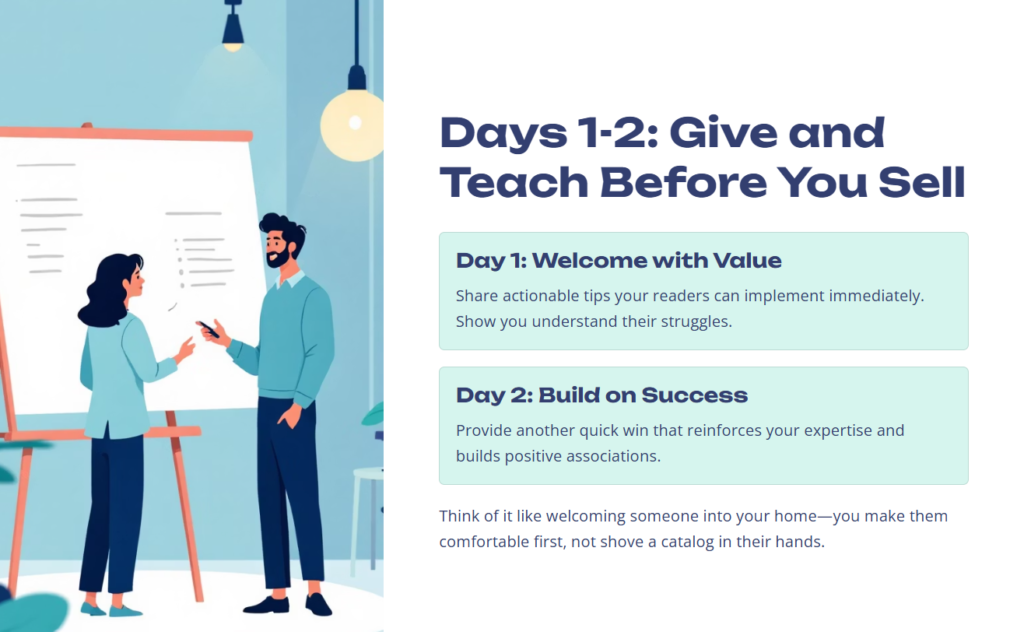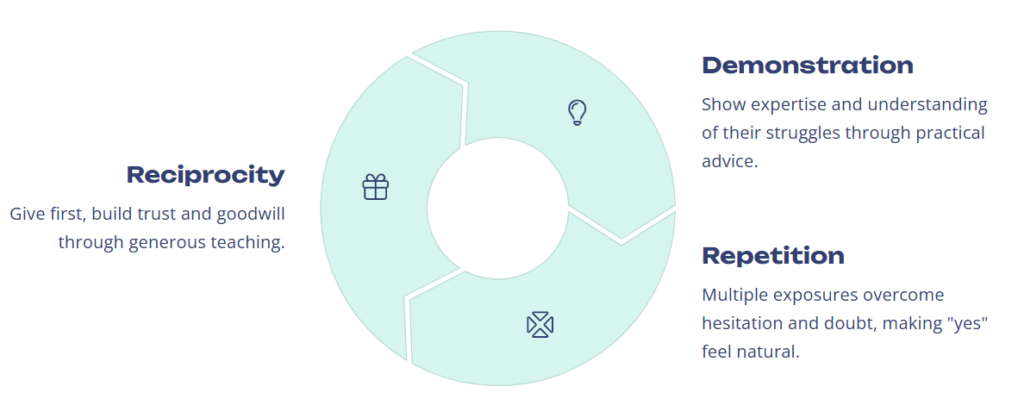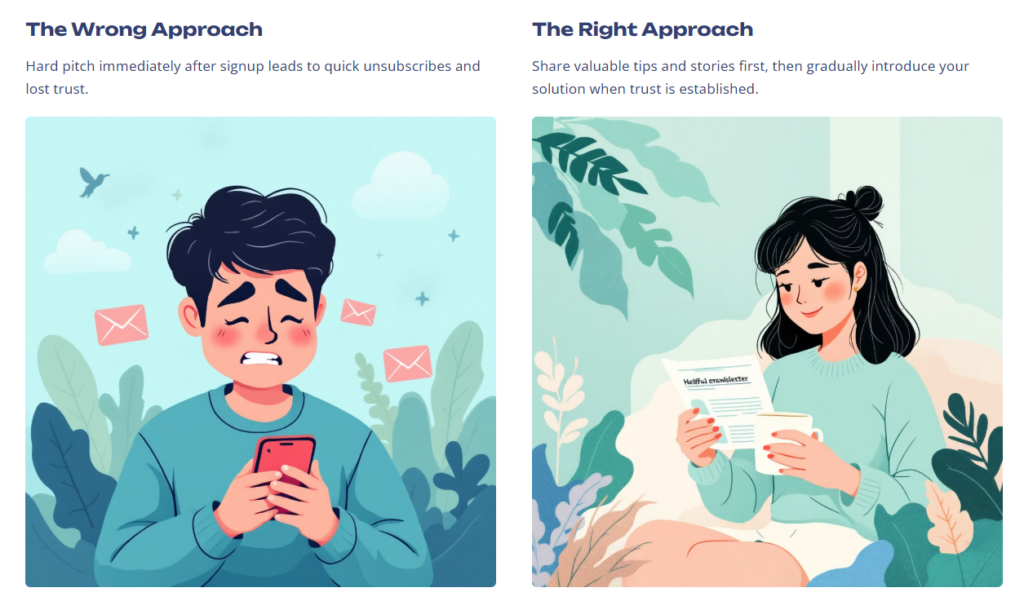Think about the last time you signed up for someone’s newsletter. If the first thing they did was send you a hard pitch, chances are you clicked away pretty fast. But if they shared something useful—maybe a tip, a story, or a quick win—you probably stuck around. That’s the power of a good email sequence.
A 5-day drip campaign is like a mini journey you take your subscribers on. You start by giving value, showing that you understand their struggles, and then gradually introduce your solution. By the time you make your offer, your readers already trust you and see the connection between their needs and what you’re offering
In this article, we’ll walk through how this simple but smart 5-day strategy works, why it’s effective, and how you can use it to turn new subscribers into happy customers.
Day 1–2: Give and Teach Before You Sell

The first two days of your sequence are all about generosity. Instead of rushing in with an offer, you start by giving your subscribers something genuinely useful. Think of it like welcoming someone into your home—you don’t shove a catalog in their hands the moment they step through the door. You make them feel comfortable first.
In practice, this means sharing tips, insights, or quick wins that your readers can put into action right away. For example, if you’re promoting a digital course on passing the accountant certification exam, Day 1 might include a simple memory hack for retaining key tax codes, while Day 2 could walk them through a proven time-management trick for test day. These bite-sized wins show your audience that you understand their struggles and know how to help.
When you take this approach, two powerful things happen: your subscribers start to trust you, and they also begin to associate you with positive results. Even before you mention your course, they’re already thinking, “If this is what I get for free, imagine what I’d learn if I invested!”
Day 3: The Transition from Teaching to Pitching
By Day 3, your subscribers are already warming up to you. You’ve given them two solid pieces of advice, and they’ve started to see that your tips actually work. This is the perfect moment to shift gears—still offering value, but now hinting at the bigger solution you have for them.
Let’s say you’re promoting a digital course on passing the accountant certification exam. On this day, you might share the two “must-haves” for success: a clear study strategy and plenty of targeted practice questions. You explain why these matter, maybe even give a mini sample exercise, and then naturally connect the dots: “In my course, I’ve built a full system that combines both of these, so you don’t have to figure it out alone.”
This approach doesn’t feel pushy because it flows directly from the advice you’ve already given. You’re not selling out of the blue—you’re showing how your course is simply the complete version of what they’ve already found helpful.
Day 4–5: Making the Confident Pitch
By Day 4, it’s time to lean into your offer with confidence. You’ve already proven your value through helpful lessons, and now your readers are primed to hear about the full solution. Think of it as saying, “You’ve seen how these small tips help—imagine what happens when you have the complete roadmap.”
For an accountant exam prep course, this is where you stop dancing around the edges and show the benefits clearly. Explain how your program gives students structured study plans, practice tests, and coaching that shortens their learning curve. Share what makes your course unique: maybe it’s built around the exact exam format, or maybe it includes strategies to stay calm under pressure.
Day 5 is your follow-up nudge. Some people need a little extra encouragement before they take the leap. This email can highlight success stories, testimonials, or the relief students felt when they finally passed after struggling on their own. Adding urgency here—like enrollment closing, a bonus expiring, or reminding them that the exam is coming up—helps people act instead of putting it off.
The key across these two days is clarity and confidence. You’ve earned the right to make the pitch, and now you’re simply showing readers that the next step is available, waiting for them to take it.
The Psychology Behind the Sequence

The real magic of this 5-day email framework comes from how it balances generosity with confidence. By starting with two days of pure teaching, you build trust and goodwill. Readers think, “If these free tips are already helping me, what else could I gain if I dive deeper?” That’s reciprocity in action—they’re more open to giving back because you’ve already given first.
Then, when you transition on Day 3 into blending advice with a subtle product mention, you’re laying the groundwork for the next step. You’ve demonstrated your expertise, shown you understand their struggles, and started painting the picture of what life could look like with your full solution.
So why focus heavily on pitching during Days 4 and 5? It’s simple: people rarely buy the first time they see an offer. Most need a few reminders, a bit of reassurance, and often a nudge of urgency. That’s why these two days are dedicated to presenting your course clearly and repeatedly. The repetition helps cut through hesitation and doubt, while the second pitch often catches those who were “almost ready” but needed just one more reason to commit.
Think about it—when someone is preparing for their accountant exam, they might hesitate because of cost, fear of failure, or simply procrastination. By showing them proof, testimonials, and clear benefits across two separate emails, you’re tackling those objections head-on. The more times they hear your message (without it feeling spammy), the more natural and safe the decision becomes.
This balance—value upfront, transition in the middle, and confident pitching at the end—is what makes the 5-day sequence such a powerful conversion tool. It’s not about tricking people; it’s about guiding them step by step until saying “yes” feels like the obvious choice.
Action Steps: How to Create Your Own 5-Day Drip
Now that you know the flow, how do you actually put it into practice? Here’s a simple roadmap you can follow to create your own 5-day campaign:
Plan two days of teaching content. Think of quick wins your audience can use right away. For an accountant exam course, that could be a memory hack for formulas and a daily study habit that saves hours.
Blend teaching with a soft pitch on Day 3. Share a tip that naturally connects to your course, like the importance of practice exams, and then explain how your program provides structured support.
Write two clear, confident pitch emails for Days 4 and 5. Highlight your course’s biggest benefits, include student success stories, and add urgency (like a bonus expiring or the next exam date approaching).
Automate it. Load your emails into your email marketing software so every new subscriber experiences this sequence, start to finish, without you lifting a finger.
The beauty of this system is that once it’s set up, it works for you in the background—building trust, showing value, and turning readers into students.
Conclusion: From Free Value to Loyal Customers

At the end of the day, a 5-day drip campaign isn’t just about making a sale—it’s about building a relationship. By starting with genuine value, easing into your offer, and then pitching with confidence, you create a journey that feels natural for your readers. For someone preparing for their accountant exam, that journey begins with helpful study tips and ends with a clear path to success through your course.
When done right, this strategy doesn’t feel like selling—it feels like guiding. And that’s exactly why it works.